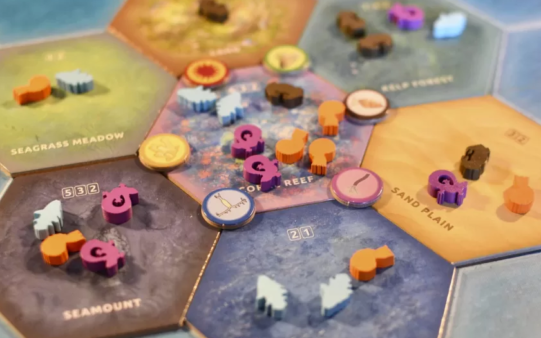Wage evolutionary war in Dominant Species: Marine – game of survival of the fittest in the oceans, seas and rivers of the world, as your animals fight to be the dominant species.
Introduction
Worker Placement is one of the most popular and beloved mechanics in board games and it’s always refreshing to see unique interpretations of this mechanic. The original Dominant Species was such a game, with worker placement effects occurring at the end of the round in descending order, with more powerful effects/actions happening after potentially less impactful effects/actions are resolved. It became an instant hit for GMT Games. However, it was also criticized for being too long and a bit too mean spirited.
So designer Chad Jensen worked on a sequel of sorts that addressed these perceived ( by some) shortcomings of the original, to provide a faster playing, smoother experience. He designed Dominant Species: Marine (DS:M), also published by GMT Games. Unfortunately he passed away before it could be published, but the whole design was completed by then and thus he posthumously remains the credited designer of the game. Chad was well loved, especially by the wargame community, for his unique designs and affable character. Dominant Species Marine was his last game and this review is dedicated to his memory.
What’s in the Box
Just like most GMT Games, DS:M adapts a minimalistic look with high quality components. The game board is 34×22 inches with colorful art. The centermost portion represents earth tiles, and to the right you will find the Player Action Spaces, aka worker placement spaces. There are 4 animal player boards of thick cardboard stock, representing the different animal types in the game. These player boards also serve as a player aid as all basic worker placement actions are explained on the board.
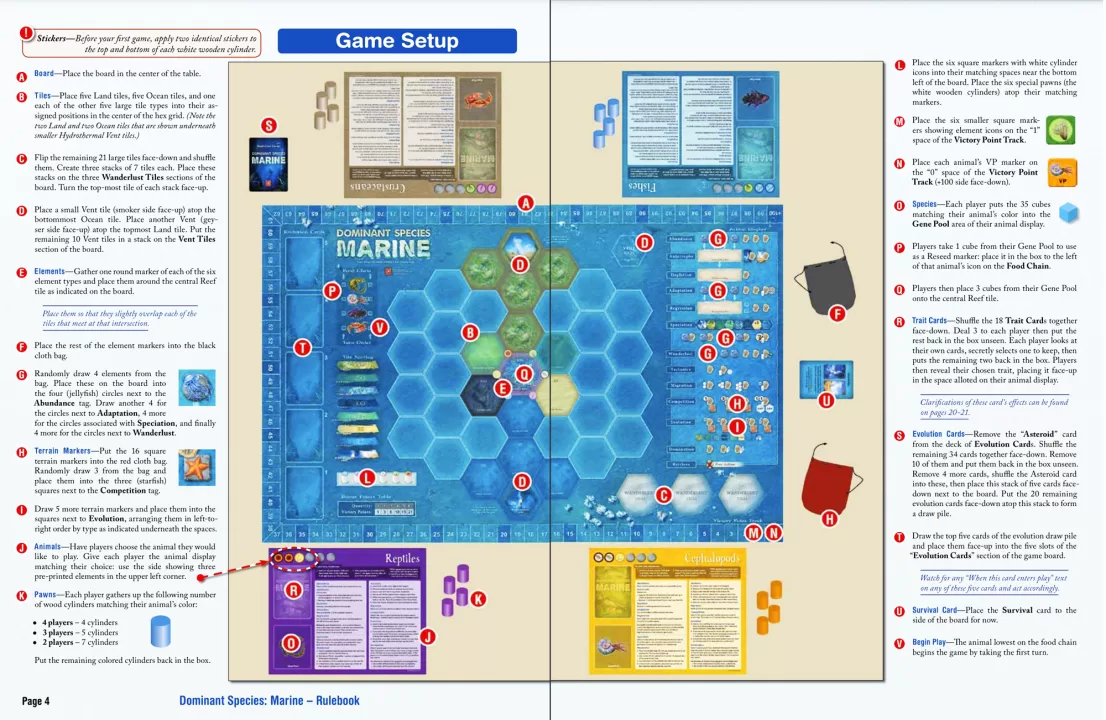
Components and setup from the rulebook
The game also includes wooden cubes and cylinders representing the 4 animals species (reptiles, cephalopods, fish, crustaceans), cards in thick glossy cardstock, white wooden cylinders with stickers representing domination pawns, and 2 cloth bags. All components are of good quality and gives the game table presence. But if you’re the type who likes miniatures or Kickstarter level game production, you won’t find it here. Personally, I prefer the more subtle, minimalistic style that GMT Games adapts, but some DSM enthusiasts have adapted upgraded game components from 3rd party game shops to customize the look of the game.
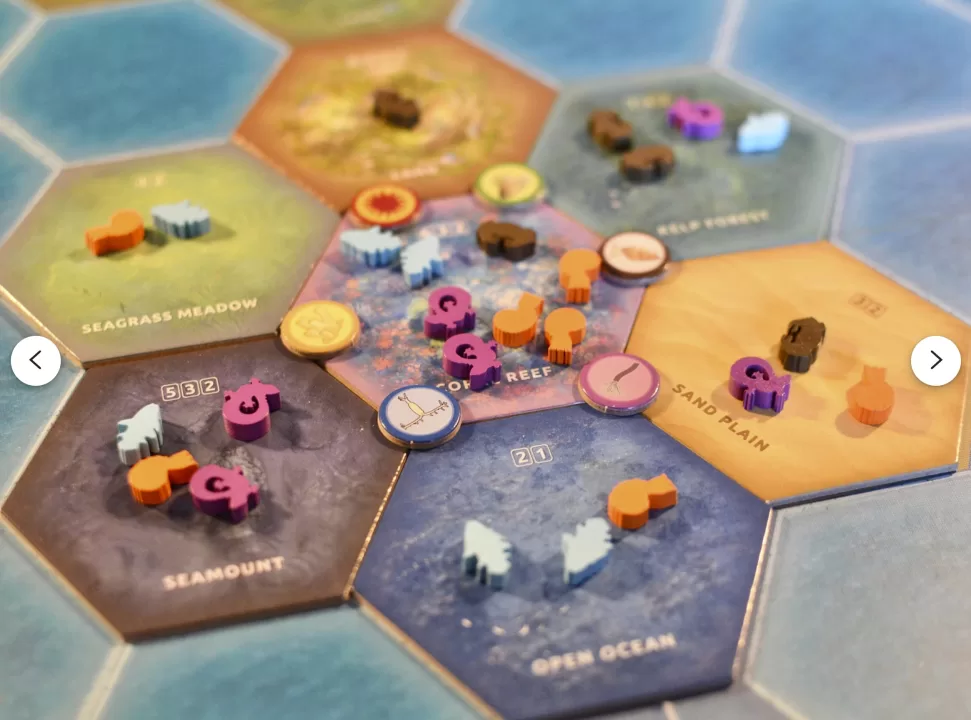
Custom components from TheGameKnightUK
Not Your Grandaddy’s Worker Placement
At it’s heart DSM is a worker placement and area control game where players try to earn the most Victory Points (VP). Players choose from 4 animal types (reptiles, cephalopods, fish, crustaceans), and try to propagate it’s species (cubes) throughout terrain tiles on Earth while scoring points. Each Animal Display (player) comes with 3 pre printed food elements and space for 3 more. Animal Species (aka player cubes) can only thrive in tile spaces with a food element they can consume (ie that’s on their Animal Display). If cubes are placed on tiles without a viable food element, the cubes are said to be Endangered and will be vulnerable during an Extinction Event where they can be permanently eliminated from the game.
On a player’s turn, he places Action Pawns on Player Action Spaces, but he can only place pawns to the right and below the last pawn he placed. The Abundance space allows the player to place food elements on earth. The Adaptation action allows the player to add more food elements to his Animal Display. The Speciation action spreads his species (cubes) on Earth. Wanderlust adds more terrain tiles to Earth and provides bonus scoring opportunities. Tectonics places Vent Tiles over other other terrain tiles (overriding its scoring value); provides bonus scoring opportunities; and can remove other players’ species cubes from the tile. Migration allows cube movement to adjacent terrain tiles. Competition eliminates (ie removes from the game) other player cubes. Evolution allows a specific terrain tile to be scored (VP’s earned are printed on the tiles) and the opportunity to play an Evolution Card. Evolution Cards have a one time effect, and depending on game conditions, can net you a bunch of points or can propagate your species or eliminate opponent cubes; or some other significant effect. The used Evolution Card is then replaced. Some Evolution Cards have game effects when they enter play. With the Domination action, players can claim white Domination pawns that are not only additional action pawns but also do not need to adhere to the “place to the right and below your last pawn placed rule” and also have their own special action spaces. And lastly, players can take the Retrieve action, which allows you to return all your pawns (including controlled white Domination pawns) back to your supply.
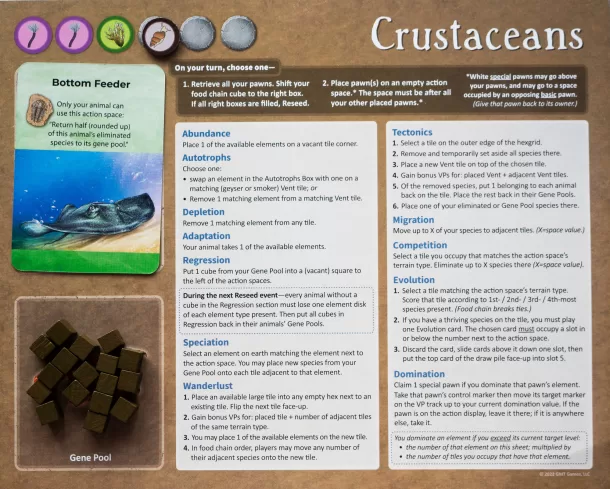
The Animal Board lists available actions
Whenever a bonus scoring opportunity occurs, players consult the Bonus Points Table and this gives multiplier points for VP’s. So, for example a Wanderlust action calls for a bonus from 3 adjacent terrain tiles, the player doesn’t score 3 VP’s but 6 based on the Bonus Points Table.
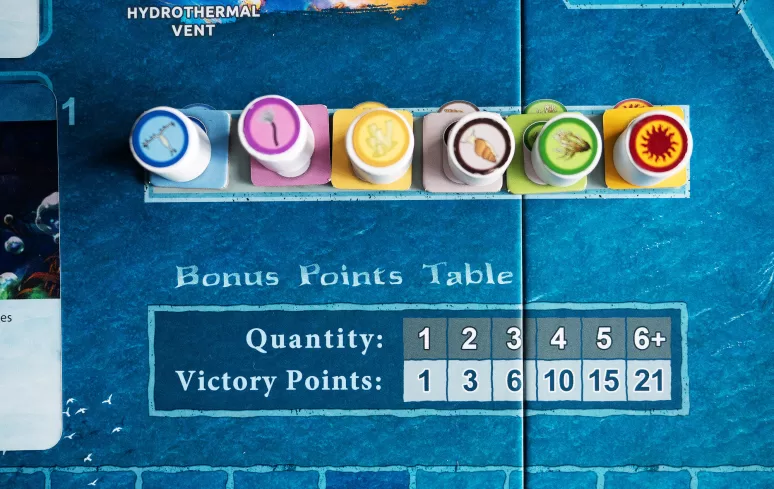
Maximizing use of the Bonus Points Table is key
Play continues until the Asteroid Card is played after which all tiles are scored together with Domination points VP’s. The winner in VP’s is the victor.
However there are many other game nuances such as additional actions (Regression, Autotrophs, Depletion); Special Action Spaces; Reseeds and resets, which I will not cover in this article as it would make it too long. For a more comprehensive look at gameplay, check out the online rulebook or watch the How to Play video from BoardGameGeek.
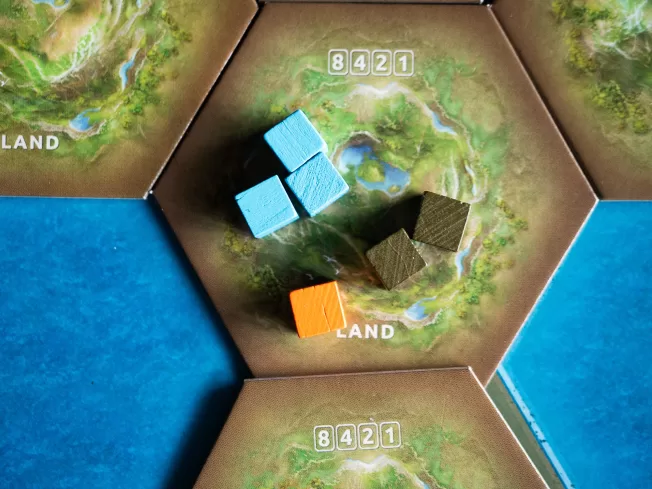
Scoring a tile. Blue gets 8 points, Brown 4 and Orange 2
Strategy and Tactics
Dominant Species: Marine is not a new game, it came out in 2021, in the middle of the COVID pandemic. Because of this, I feel that it didn’t get as much exposure as it should have. DS:M is not a “eurogame” by any means. Although, worker placement is one of the most predominant mechanics in euro games, DS:M has high player interaction and has direct conflict in spades. However, it can play quite differently depending on player count. A 2-player game can be played more euro-like since there is enough space to expand, so players can explore non conflicting strategies and score points with little interference from the opponent. Also, certain Evolution Cards that necessitate direct player interaction may lose some value in these efficiency play games. At 3- or 4- players however, board space, action spots, cards, resources and scoring opportunities become scarce and it is inevitable to have conflict. This is the way it is meant to be played, but it is still refreshing to know that the 2 player game can offer a more relaxed, peaceful gaming experience.
There is lots of choice in the game. The Action Spaces provide many strategic options, with the more powerful actions towards the bottom of the action space. So players will also have to weigh whether they should rush towards spaces like Evolution and Dominance while forfeiting placement of spaces above, and using up a turn for an early Retrieve action. Also, game state changes frequently and sometimes, abruptly. It is easy to have an opponent undo your last couple of moves by playing a powerful Evolution Card, but the game does not feel unnecessarily swingy nor random. You also get the same opportunities to mess your opponent’s plans or recover from aggressive moves. And like other good strategy games, it is sometimes prudent to deny an opponent a strong scoring opportunity or action, even if this action would give you suboptimal direct benefits. Because of the constant ebb and flow of gameplay, players will definitely have to make tactical adjustments and execute strategic pivots to stay in contention of winning. But this is not a wholly tactical exercise, where one is just relegated to reacting and putting out fires. In fact, it would be impossible to win without long term strategic level thinking – players just have to be flexible enough to adapt to changing game states.
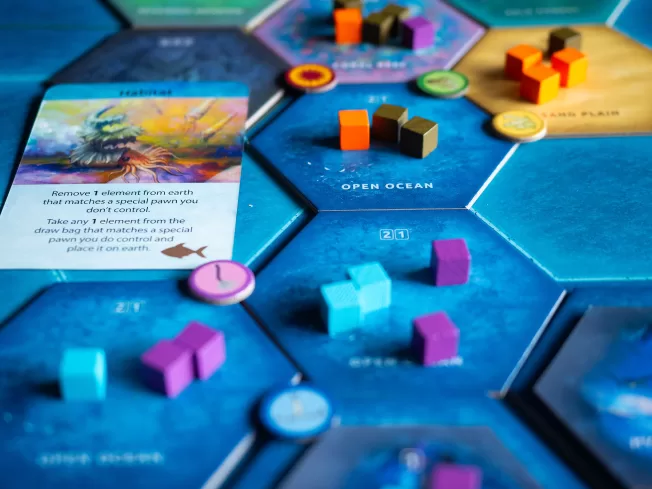
Ocean tiles score less but have lots of Evolution Cards that benefit species there
To those familiar with a bit of evolutionary science, the names of Action Spaces make perfect sense and their actions mirror these scientific concepts. If you are unfamiliar with these terms, it may seem confusing at first, but after a round or two the action spaces become intuitive and understanding them is greatly helped by the Animal Player Board. The constant interaction and competition amongst species cubes vying from limited space on Earth and trying to thrive more in higher scoring Terrain Tiles also resonates with the evolutionary survival theme.
The game board itself constantly changes. Animals (players) discover new Terrain Tiles and habitats due to their Wanderlust (Action). Volcanic activity thru the Tectonics Action opens up vents which can disrupt an opponent’s plan to populate high scoring tiles such as Land terrain. Evolution Cards can lead to population explosions, depletion of food supplies, disease, symbiotic opportunities or predation. The game does an amazing job staging the different forces of change. There is randomness in the game but it is not randomness just meant to throw off player’s strategies. It completely matches with the evolutionary theme – there are just some events you cannot completely prepare for. But smart play can put players in a position to better weather these events ( as brought out by other players or card draws) and game design gives players ample opportunity to claw and fight back in a very thematic “survival of the fittest” design. As such, I feel this is a great example of how to mesh a strategy game with random elements.
According to Kai Jensen, the wife of designer Chad, and the developer of the game, DSM started out as a an expansion, but developed into its own design later in development. After receiving feedback on the original, it was obvious that a significant number of players wanted a faster playing game with less capacity for other players to screw up their moves ( the original Dominant Species used a programmed worker placement mechanic) and gameplay that was less prone to analysis paralysis. Those were the main driving forces to the changes in DSM. Kai said in our Zoom conversation that, as interesting as the changes were on the new iteration, Dominant Species was her favorite game, and it held a special place in her heart being the first game she was involved in. However, upon playing it for the first time, it was evident to her that DSM was the more playable and enjoyable of the two, and is now her favorite game. As such, the original Dominant Species is still a well loved best seller for GMT Games.
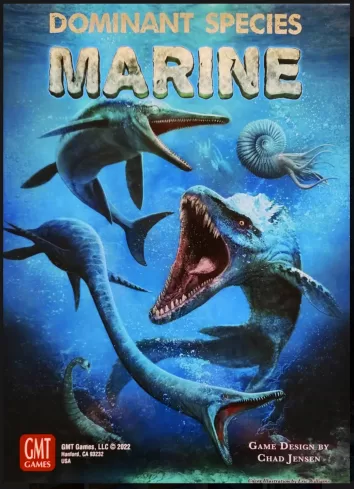
Box Art from the 2nd printing
A Great Last Hurrah
Chad Jensen passed away in November 2019. He was a well known designer in the wargame circles, although his games are known to incorporate mechanics from other game genres, in more “euro friendly” designs. He started designing his own games at age 8 and had his first commercial release in 2006 with Combat Commander: Europe. According to his wife, Kai, his main design philosophy has always been to design games he wanted to play himself. She describes him as “generous, intelligent, kind, determined, loyal, honorable, strong-headed, dedicated, trustworthy, opinionated, funny, quick-witted, open, caring… all that with a small side of grumpy”.
Dominant Species Marine is the last game he designed in full. And it is a great testament to Mr. Jensen as a designer. It integrates the theme flawlessly, has player interaction and scoring optimization in spades, provides good strategic and tactical level nonlinear gameplay, can be taught to casual players, doesn’t overstay it’s welcome in terms of game length, and is definitely a fun play. However, if you are a gamer who enjoys a more multiplayer solitaire experience, this may not be for you – but I still urge you to give it a try.
And if you liked Dominant Species Marine, try out his other games – Dominant Species, Combat Commander:Europe, Combat Commander:Pacific, Urban Sprawl, Fighting Formations, Welcome to Centerville, Dominant Species: The Card Game, Combat Commander: Resistance!, Downfall: Conquest of the Third Reich (co-designer).
Review Score: 9/10
Related:

